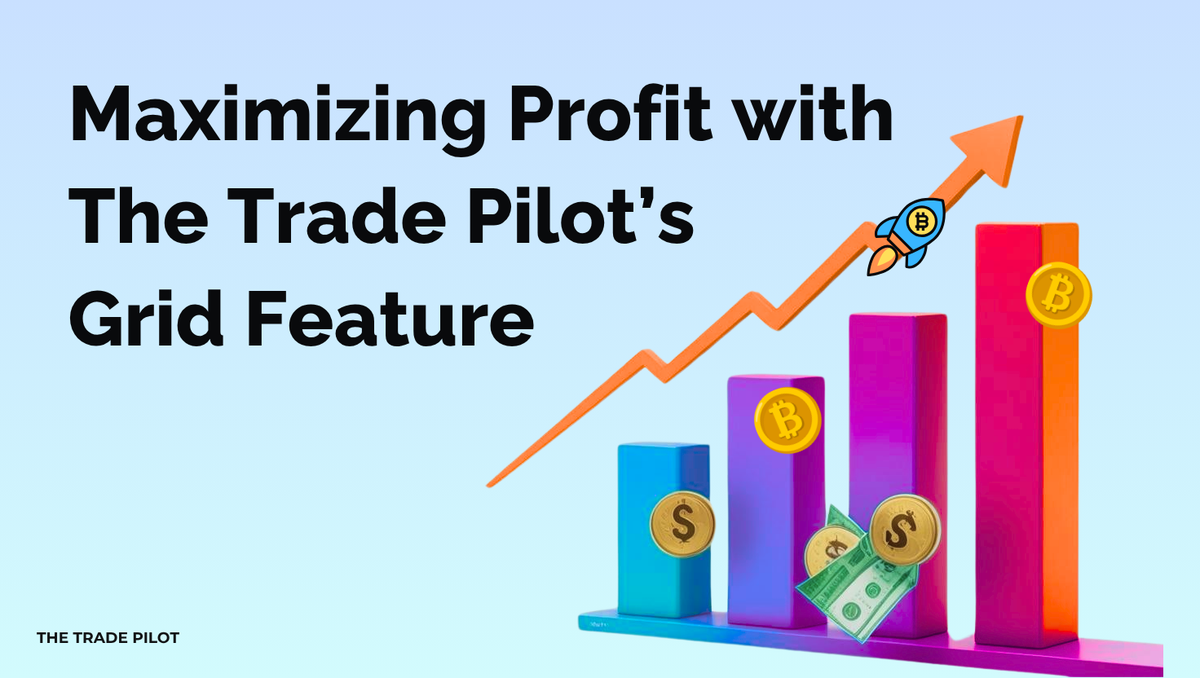Learn how to use The Trade Pilot’s Grid Trading feature to capitalize on market volatility. Discover how it works, how to configure it, and how it can help you maximize gains in any market.
Grid trading is a powerful automated strategy designed to profit from market volatility. It works by placing a series of buy and sell orders at incremental price levels above and below a base price. As prices fluctuate, the bot buys low and sells high in repeating cycles, locking in gains over time.
The Trade Pilot makes grid trading simple and highly customizable, allowing traders to tailor settings to their preferred risk and return profile.
How Grid Trading Works
Imagine a coin priced at $100. With grid trading enabled, the bot can be configured to place buy orders every 5% drop and corresponding sell orders at a profit target above each entry. For example:
- Buy at $95 → Sell at $97.85 (3% profit)
- Buy at $90 → Sell at $92.70
- Buy at $85 → Sell at $87.55
Each buy/sell pair operates independently, capturing profits from short-term rebounds within a volatile price range.
Grid trading performs best in sideways or volatile markets where price action stays within a range.
You can read more about Grid trading here.
Core Grid Configuration Options in The Trade Pilot
- Rebuy Trigger: Triggers a buy after a specified % price drop.
- Automatic Rebuys: When enabled, the bot automates the entire process. When disabled, users must rebuy manually.
- Maximum Rebuys: Limits how many rebuys can be made, controlling risk.
- Rebuy Based On: Choose between Base Order or Total Invested to define the rebuy size.
- Level Multiplier / Growth Rate: Used to increase rebuy sizes progressively.
- Take Profit: Defines the % gain at which each position is sold. A setting of 0 disables auto-selling, useful for long-term holds.
- Merge Rebuys: When on, combines multiple buys into one position with adjusted average price and size. When off, each trade is treated separately.
Example 1: Standard Grid Strategy
- Base Order: $100
- Rebuy Trigger: 5% drop
- Maximum Rebuys: 3
- Take Profit: 3%
- Level Multiplier: 1.0
- Growth Rate: 1.0
- Rebuy Based On: Base Order
This creates a classic grid system with fixed rebuy amounts. Each rebuy is $100, placed after a 5% drop, with a corresponding 3% profit target. It’s a low-risk, steady approach ideal for smaller accounts.
Rebuy Values:
- Rebuy 1: $100
- Rebuy 2: $100
- Rebuy 3: $100
Total Invested: $400
Example 2: Aggressive Grid Strategy with Compounding Rebuys
- Base Order: $100
- Rebuy Trigger: 5% drop
- Maximum Rebuys: 3
- Take Profit: 3%
- Level Multiplier: 1.1
- Growth Rate: 1.2
- Rebuy Based On: Total Invested
This strategy increases each rebuy amount based on the total invested so far.
Formula:
rebuy_value = base_value × growth_rate × level_multiplierlevel
Rebuy Calculations:
- Level 1: $100 × 1.2 × 1.1^1 = $132.00
- Level 2: $232.00 × 1.2 × 1.1^2 ≈ $337.99
- Level 3: $469.99 × 1.2 × 1.1^3 ≈ $760.30
Total Invested: $100 + $132.00 + $337.99 + $760.30 = $1,330.29
This strategy accelerates rebuy amounts to strengthen recovery and averaging. However, it requires much more capital and increases downside risk.
Note: This is a highly aggressive setup. If the price keeps falling, all rebuys could be triggered without recovery, resulting in a large open position. A more moderate configuration often delivers a better balance of risk and reward.
Strategy Comparison
- The Standard Strategy uses fixed-size rebuys and is easier to control in terms of risk. It requires less capital and is slower to reach break-even after a price drop.
- The Aggressive Strategy uses increasing rebuys based on total invested with multipliers and growth rate. It can help reach break-even faster during a rebound, but it comes with a higher risk of capital drain if the market continues to fall.
Example 2 is very aggressive, and while it may recover faster during rebounds, it can also deplete your funds quickly. A reasonable setup lies somewhere in between, with mild multipliers and growth rate settings.
How to Maximize Profit with The Trade Pilot’s Grid Feature
- Use Total Invested as your rebuy base — this is usually sufficient for effective recovery.
- In most cases, you don't need to set multipliers if you're already using total invested — this alone allows for dynamic scaling.
- If using multipliers, keep them moderate, avoid high multipliers (1.5+) unless you have strong capital backing and understand the risks.
- Take Profit can be any % — setting it to 0 means the position won't auto-sell and must be closed manually. This is useful for long-term investing rather than short-term trading.
- Merge Rebuys is useful and recommended — it simplifies positions and accelerates recovery through averaging.
- ⚠️ Always calculate your rebuy levels and total exposure before running the bot. Make sure you have funds available for the worst-case scenario where all rebuys are executed.
When to Use Grid Trading
Grid trading works best in:
- Sideways or choppy markets
- Traders aiming for frequent small profits
- Coins with clear support and resistance zones
Avoid in trending markets unless paired with stop-loss or protective features.
Final Thoughts
The Trade Pilot’s Grid system offers flexible tools to turn volatility into opportunity. Whether you prefer a conservative grid or a more aggressive compounding setup, success depends on managing your capital and configuring your strategy wisely.
Test your settings, monitor performance, and optimize over time. With the right setup, your bot can profit passively — even in turbulent markets.

